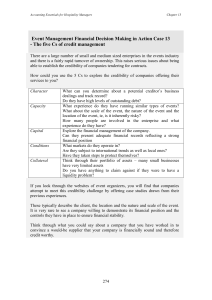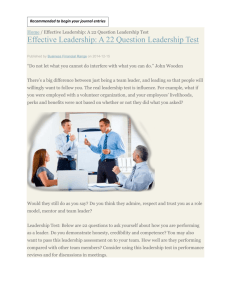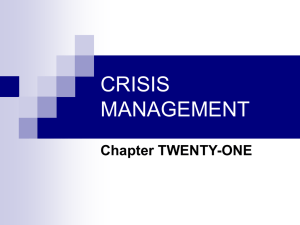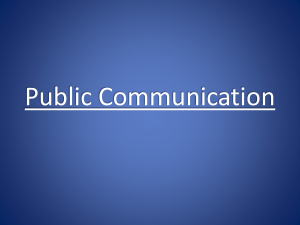Trust - CUPS
advertisement
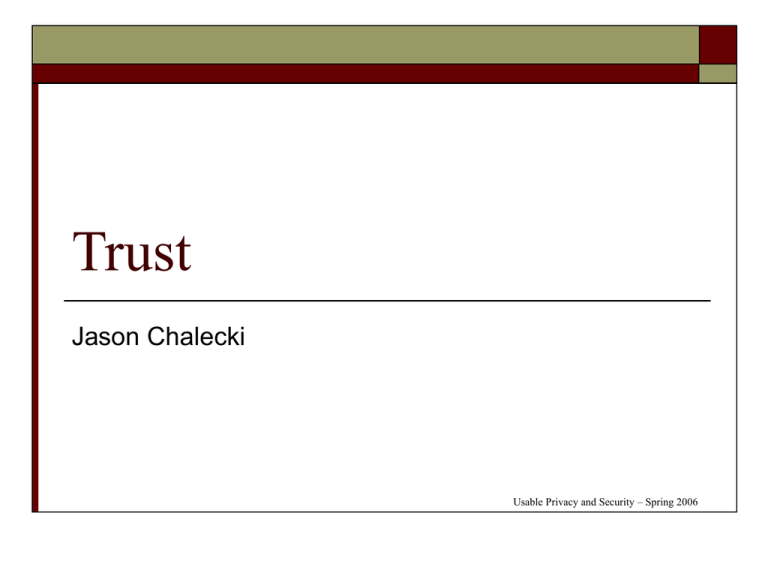
Trust Jason Chalecki Usable Privacy and Security – Spring 2006 Not much trust e-commerce sites 29% trust either "just about always" or "most of the time" 64% trust "only some of the time" or "never" consumer advice sites 33% trust 59% low levels of trust An online problem? small businesses newspapers and television news 55% trust charities and other nonprofit organizations 58% trust financial companies such as banks, insurance companies and stockbrokers 68% trust 54% trust federal government 47% trust at least most of the time From A Matter of Trust: What Users Want From Web Sites Lost or lacking trust Napster (2003) Jakob Nielsen (Alertbox 1999) Very long pauses between songs. I dropped the service and haven’t been back, even though, when it worked, I loved it. Would probably love the eFax service, but didn’t sign up because he would be locked in. Amazon.com (1999) They admitted that many favorable reviews had been paid for But the flawed policy was terminated and the damage to the customer relationship was mended by an offer to refund any purchase that had been based on a paid recommendation. Trust is fundamental to security Lack of trust results in systems being ill-used or used not at all Lack of understanding of trust results in wrong decisions or no decisions Too much trust can be more dangerous than too little E.g. I can open any file attachment because I run anti-virus software Fundamental questions How to reliably represent trust in different interactions and interfaces How to transform trust-based decisions into security decisions while maintaining the meaning of the trust-based decisions What are the building blocks of trust How is trust fallible How can trust’s fallibility be addressed Definition assured reliance on the character, ability, strength, or truth of someone or something (Merriam-Webster) Concerns a positive expectation regarding the behavior of somebody or something in a situation that entails risk to the trusting party (Patrick, Briggs, and Marsh) Layers Dispositional trust Learned trust Psychological disposition or personality trait to be trusting or not A person’s general tendency to trust, or not to trust, as a result of experience Situational trust Basic tendencies are adjusted in response to situational cues Granularity I trust you I trust you this much I trust you this much to do this thing Another axis Hard trust technology Soft trust social Processing strategies Heuristic approach making quick judgments from the obvious information Systematic approach involving detailed analysis of information Credibility How is this different than trust? Credibility How is this different than trust? Credibility is believability Trust is dependability “Credibility and Computing Technology” Four Types of Credibility Presumed credibility. Reputed credibility. Surface credibility. Experienced credibility. Presumed credibility Belief based on general assumptions Reputed credibility Belief based on third-party reports Surface credibility Belief based on simple inspection Experienced credibility Belief based on one’s own experience “Credibility and Computing Technology” Four Types of Credibility Presumed credibility. Reputed credibility. Surface credibility. Experienced credibility. How do these relate to the layers of trust? Judgments of credibility Prominence Involvement of the user Topic of the web site Nature of the user’s task User’s experience Individual differences Interpretation Assumptions in a user’s mind Skills and knowledge possessed by user Context for the user Time Initial trust Interactions Long-term trusted relationship Trustworthiness Ability Integrity Capacity to keep promises Actually keeping promises Benevolence Acting in another’s best interest Bhattacherjee’s Model Willingness to Transact + Familiarity + + Trust Lee, Kim, & Moon’s Model + Comprehensive Information + Trust Shared Value + + Communication - Uncertainty Number of Competitors Specificity + - + Customer Loyalty Transaction Cost Corritore’s Model Perception of: Credibility External Factors Ease of Use Risk Trust Egger’s Model (revised) McKnight’s Model Disposition to Trust Institution-Based Trust (perceptions of the Internet environment) Trust Beliefs (perceptions of specific web vendor attributes) Trusting Intentions (intention to engage in trust-related behaviors with a specific web vendor) Trust-Related Behaviors Riegelsberger’s Model TRUSTER Separation in Space TRUSTEE +UNCERTAINTY Outside Option Withdrawal Signals Trusting Action Separation in Time +UNCERTAINTY Fulfillment Nonfulfillment Models Comparison Can be successfully operationalized, typically into questionnaires Components of trust Ability Integrity Benevolence Many factors may affect trust Trust Design Guidelines 1. 2. 3. 4. 5. 6. 7. 8. Ensure good ease of use. Use attractive design. Create a professional image – avoid spelling mistakes and other simple errors. Don’t mix advertising and content – avoid sales pitches and banner advertisements. Convey a “real-world” look and feel – for example, with use of high-quality photographs of real places and people. Maximize the consistency, familiarity, or predictability of an interaction both in terms of process and visually. Include seals of approval such as TRUSTe. Provide explanations, justifying the advice or information given. 9. 10. 11. 12. 13. 14. 15. Include independent peer evaluation such as references from past and current users and independent message boards. Provide clearly stated security and privacy statements, and also rights to compensation and returns. Include alternative views, including good links to independent sites with the same business area. Include background information such as indicators of expertise and patterns of past performance. Clearly assign responsibilities (to the vendor and the customer). Ensure that communication remains open and responsive, and offer order tracking or an alternative means of getting in touch. Offer a personalized service that takes account of each client’s needs and preferences and reflects its social identity. Stanford Guidelines for Web Credibility 1. 2. 3. 4. 5. 6. 7. 8. 9. 10. Make it easy to verify the accuracy of the information on your site. Show that there's a real organization behind your site. Highlight the expertise in your organization and in the content and services you provide. Show that honest and trustworthy people stand behind your site. Make it easy to contact you. Design your site so it looks professional (or is appropriate for your purpose). Make your site easy to use – and useful. Update your site's content often (at least show it's been reviewed recently). Use restraint with any promotional content (e.g., ads, offers). Avoid errors of all types, no matter how small they seem. Stanford Persuasive Technology Lab http://www.webcredibility.org/guidelines/ Jakob Nielsen’s Guidelines Design quality Up-front disclosure Comprehensive, correct, and current Connected to the rest of the Web Trust or Bust: Communicating Trustworthiness in Web Design Jakob Nielsen's Alertbox, March 7, 1999 http://www.useit.com/alertbox/990307.html Guidelines Comparison Professional appearance and ease of use are very important Be correct and verifiable Be part of a larger community Microsoft and Users and Trust Trust Question Failings Often, the question being presented is a dilemma rather than a decision Computers can’t help interpret emotional cues because they behave in a purely logical way Users don’t want to deal with the trust issues presented to them Users don’t want to reveal personal data User Behavior What users say they do and what they actually do often differ Users don’t necessarily want to think about the consequences of their behavior Users make one-off decisions about trust Users conceive of security and privacy issues differently than developers do Users have many superstitions about how viruses are propagated Before XP SP2 XP SP2 Help for “downloading” decision Help for “running” decision Recommendations Let users make trust decisions in context Make the most trusted option the default selection Present users with choices, not dilemmas Always respect the user’s decision
